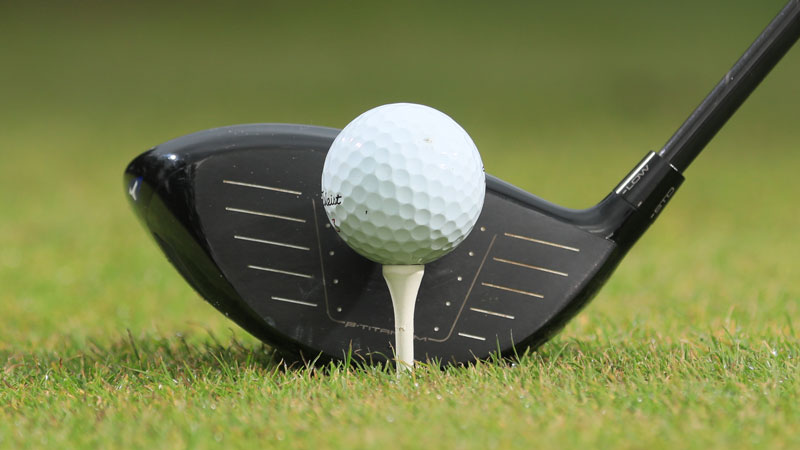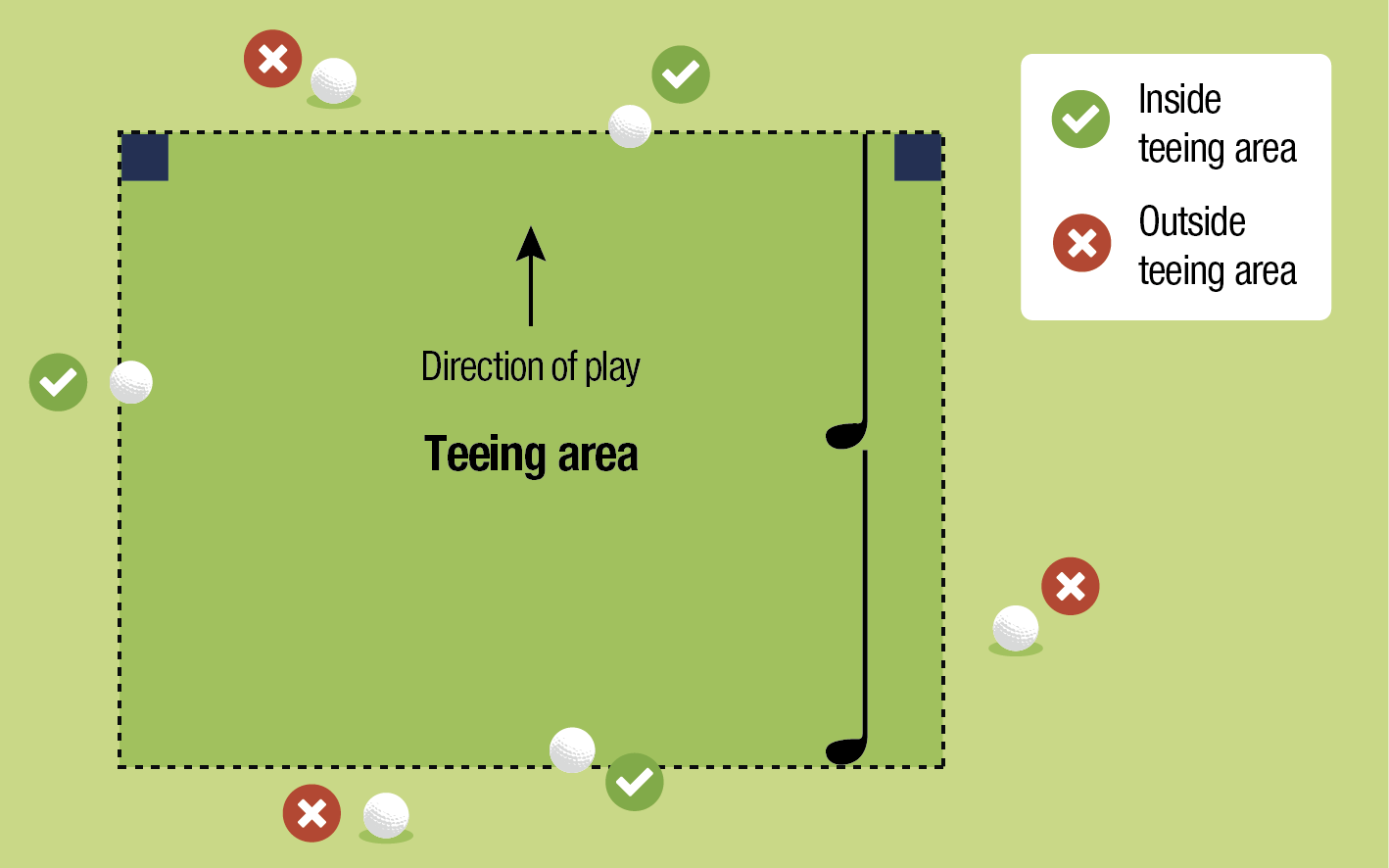Rules of Golf: The Teeing Area
Jeremy Ellwood explains what the Rules mean by 'teeing area' and what happens if you inadvertently play from beyond its boundaries


When referring to the tee, most golfers will naturally think of the tee box – often raised - from which they start every hole. But ‘teeing area’ under the Rules of Golf is one of the definitions you really need to know as it is a very precisely defined area. The teeing area is a rectangle two club-lengths in depth, with the forward-most points and outer-most sides of the tee markers defining its outer limits.
‘Club-length’ is also now a defined term under the Rules (the longest club you are carrying for that round, excluding your putter), so you may have to be a little careful about how far back you go, perhaps to avoid an uneven patch of ground or to get a very precise yardage on a par 3, especially if you've decided to leave a misbehaving driver out of the bag that day!

This diagram from The R&A's Rules of Golf clearly illustrates the extent of the 'teeing area'
A ball is considered to be inside the teeing area even if only a tiny part of it overlaps the edge of the area, and it is perfectly permissible to stand outside the teeing area to play as long as your ball remains within it. This might be to make maximum use of the angle on the hole or to allow you to hit your preferred shot shape more comfortably.

There is no issue with standing outside the teeing area to play - it is where the ball is that counts
Related: 8 Rules Golfers Break Without Realising
The penalties for, or consequences of, playing from outside the teeing area or from the wrong tee are significantly different between stroke play and match play. Playing from outside the teeing area (Rule 6-1b) would most commonly occur through lack of concentration, or perhaps care, if the tee-markers are set wide apart, when it can be all too easy to end up slightly ahead of them.

Playing from just in front of the markers will have different consequences in match play and stroke play
Playing from the wrong tee may seem more unlikely, but it does happen, either through going to the wrong hole when tees are set close together on an unfamiliar course, or more likely when you absent-mindedly tee off from the yellows when the competition is being played from the whites.
Playing from outside the teeing area or from the wrong set of markers is effectively the same offence under Rule 6.1b, but while the ramifications can be quite severe in stroke play, in match play, whether or not you are penalised at all is entirely at the discretion of your opponent.
Get the Golf Monthly Newsletter
Subscribe to the Golf Monthly newsletter to stay up to date with all the latest tour news, equipment news, reviews, head-to-heads and buyer’s guides from our team of experienced experts.
In stroke play, you incur the general penalty (two strokes) and must then correct your error by playing a ball from inside the teeing area before making a stroke at your next hole, or before returning your scorecard if it happens on your final hole. Unfortunately, if you don’t correct your mistake in time, you will be disqualified.
The ‘good’ news is that any strokes with the ball played from outside the teeing area or wrong tee do not count in your score for that hole.
In match play, there is no penalty, but your opponent may immediately request that you cancel the stroke and play another ball from within the teeing area. The likelihood of this will probably depend on how good your original shot was, but if you have knocked it close on a par 3, it would be fair to assume that you will be asked to replay the shot. If, however, you have despatched it into dense jungle, don’t be too surprised if you are not asked to play again!

In matchplay, if you play from the wrong set of tees, there's no penalty, but your opponent may ask you to play again from the correct teeing area.
Related - Golf Rules: Lost Ball
Finally, any time your ball is lying in the teeing area of the hole you’re playing, it may be re-teed anywhere within that teeing area. So, if your foursomes partner almost misses it and it just topples off the tee, you may then re-tee it if it hadn't made it outside the teeing area – potentially very handy if you’re facing a long drive over water!

Jeremy Ellwood has worked in the golf industry since 1993 and for Golf Monthly since 2002 when he started out as equipment editor. He is now a freelance journalist writing mainly for Golf Monthly. He is an expert on the Rules of Golf having qualified through an R&A course to become a golf referee. He is a senior panelist for Golf Monthly's Top 100 UK & Ireland Course Rankings and has played all of the Top 100 plus 91 of the Next 100, making him well-qualified when it comes to assessing and comparing our premier golf courses. He has now played 1,000 golf courses worldwide in 35 countries, from the humblest of nine-holers in the Scottish Highlands to the very grandest of international golf resorts. He reached the 1,000 mark on his 60th birthday in October 2023 on Vale do Lobo's Ocean course. Put him on a links course anywhere and he will be blissfully content.
Jezz can be contacted via Twitter - @JezzEllwoodGolf
Jeremy is currently playing...
Driver: Ping G425 LST 10.5˚ (draw setting), Mitsubishi Tensei AV Orange 55 S shaft
3 wood: Srixon ZX, EvenFlow Riptide 6.0 S 50g shaft
Hybrid: Ping G425 17˚, Mitsubishi Tensei CK Pro Orange 80 S shaft
Irons 3- to 8-iron: Ping i525, True Temper Dynamic Gold 105 R300 shafts
Irons 9-iron and PW: Honma TWorld TW747Vx, Nippon NS Pro regular shaft
Wedges: Ping Glide 4.0 50˚ and 54˚, 12˚ bounce, True Temper Dynamic Gold 105 R300 shafts
Putter: Kramski HPP 325
Ball: Any premium ball I can find in a charity shop or similar (or out on the course!)
-
 JM Eagle LA Championship Prize Money Payout 2025
JM Eagle LA Championship Prize Money Payout 2025The LPGA Tour heads to California for the JM Eagle LA Championship, where the largest prize money payout of the season so far is on the table
By Mike Hall Published
-
 Corales Puntacana Championship Prize Money Payout 2025
Corales Puntacana Championship Prize Money Payout 2025The PGA Tour’s latest opposite field event features an attractive prize money payout and some former champions in the field
By Mike Hall Published